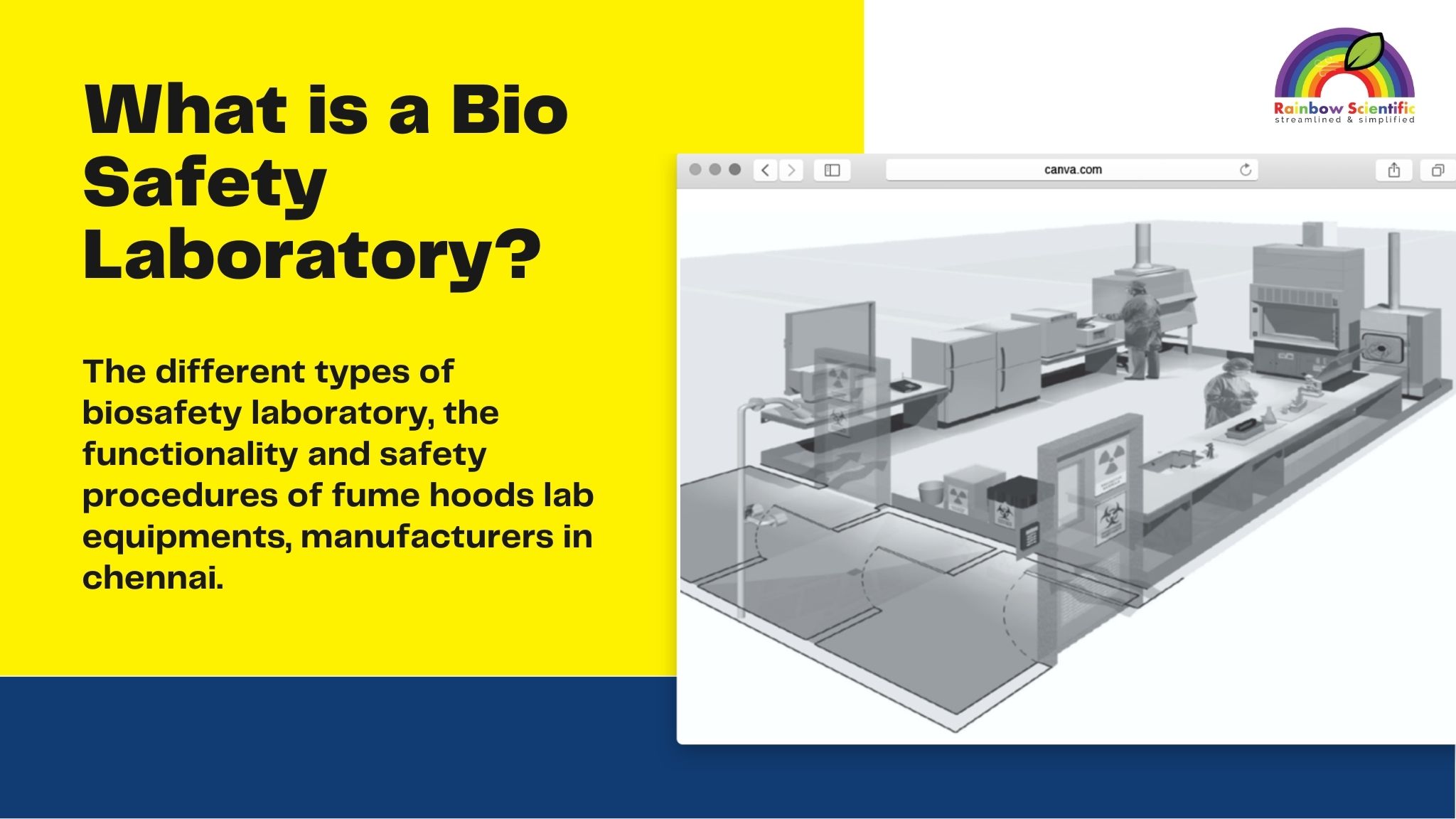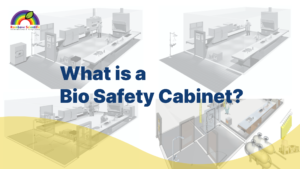There are four different biosafety laboratories, namely Biosafety Level (BSL) 1 & 2 (Basic), Biosafety Level 3 (Containment) and Biosafety Level 4 (Maximum Containment) laboratories. Biosafety levels 1 and 2 are generally used when working with microorganisms in risk groups 1 and 2. They are ideal for promoting good microbiological techniques (GMT) as they are fundamental and necessary for laboratories of all levels. The Biosafety Level 1 and 2 Code can be used to develop procedures for safe laboratory practices. GMTs are the foundation of laboratory safety. There are fume hoods manufacturers in Chennai called Rainbow Scientific who can take care of all that stuff. A laboratory safety manual should be available to identify potential hazards and establish procedures to eliminate these hazards.
Figure representing Biosafety Laboratory 1
What is Bio safety Laboratory 1 and Fume hoods uses:
BSL-1 is appropriate for work involving substances that do not cause disease and pose minimal potential danger to laboratory personnel and the environment. Work is performed on benchtops using standard microbiological procedures. Special containment equipment or equipment construction is not required, but may still be used depending on the circumstances. Laboratory personnel must have specialised training and must be supervised at all times in the laboratory. In addition, it is essential that all employees pass health checks and have a medical history recorded. Timely reporting of illness or laboratory accidents should be done and all laboratory personnel should adhere to GMT and understand its importance.
Figure representing Biosafety Laboratory 2
BSL-2 is suitable for work involving substances that pose a moderate hazard to personnel and the environment. It differs from BSL-1 in that:
- Laboratory personnel have special training in the handling of hazardous substances and are under supervision.
- While the laboratory access is restricted to everyone when the system is running
- All procedures that may generate infectious aerosols or splashes are performed in a BSC or other physical containment facility.
- Laboratory personnel must be provided with medical supervision as necessary.
- Laboratory equipments like fume hoods, pass box, laminar airflow cabinet should be regularly decontaminated.
Important basic concepts for biosafety levels 1 and 2 are as follows:
Entry procedures:
- A biohazard warning sign should be placed on the door of laboratories that handle microorganisms of risk group 2 and higher. (find the biohazard warning sign for the lab door)
- Only authorised persons have access to the laboratory.
Figure representing Biohazard warning for Biosafety laboratory – 2
Personal safety:
- In the testing environment such as fume hoods, cabinets, you must wear all the safety equipment without fail.
- Gloves are required for work that involves direct contact with body fluids and other infectious and/or caustic materials. Gloves must be removed aseptically after use.
- Hands must be washed before and after all procedures in the laboratory.
- Safety glasses must be worn to protect the eyes from acid splashes, ultraviolet radiation and objects that could injure the eyes, e.g.
- It is forbidden to eat, drink, smoke, apply cosmetics and contact lenses in the laboratory.
- Once the laboratory testing is over, avoid bringing the laboratory equipment and clothing outside of your testing environment or room. This might expose toxic gases & viruses, free radicals to the outside environment.Food storage in the laboratory is not permitted.
- Protective lab coats that have been used in the lab must not be stored in the same cabinet as the rest of the clothing.
Progresses:
- Materials must not be placed in the mouth, mouth pipetting is prohibited.
- The use of hypodermic needles should be limited. They should not be used for pipetting or any other purpose except for injection and aspirating fluids from animals.
- Laboratory incharge/supervisor/manager should be informed about the laboratory spills.
- All contaminated items must be decontaminated before disposal.
- There must be a written procedure for all decontamination and spillage.
Laboratory workspaces:
- The laboratory must be kept clean, tidy and free of materials that are not relevant to the work.
- Work surfaces must be kept free of dirt. Contaminated surfaces like laminar airflow workstations, fume hoods, vents, pipes must be decontaminated before further use.
- Packaging and shipping must comply with national and/or international rules and regulations.
Biosafety management:
- The head of the laboratory must ensure that a safety manual is developed and/or adopted.
- Basic Laboratory safety and operating training should be provided for whoever accesses the laboratory.
- All personnel should read and understand the laboratory safety manual before attempting any procedure.
- All laboratory personnel should be provided with appropriate medical examination and treatment.
A biosafety level 3 laboratory is designed and equipped to work with microorganisms in risk group 3 or with large volumes of microorganisms in risk group 2 that could lead to aerosol spread. In addition to biosafety level 1 and 2 procedures, BSL-3 improves upon the safeguards and safety programs of BSL-1 and 2. The class differences between BSL-1 & 2 are as follows:
Figure representing Biosafety Laboratory 3
- The international biohazard warning sign placed on the door of the laboratory must indicate the level of biosecurity and the name of the supervisor who controls access to the laboratory.
- Laboratory protective clothing must have a solid front over wrap coats, scrub suits, headgear and, where appropriate, overshoes.
- Lab coats with a front button and coats that do not completely cover the forearm are not suitable.
- After use, laboratory coats must be decontaminated before washing.
- When working with some agents (e.g. zoonotic agents), it is necessary to change into laboratory clothes. A complete change of clothes may be required before entering and after leaving the laboratory.
- Handle all infectious agents in a safety cabinet or other methods.
- Depending on the procedure, respiratory protection may be required.
- All employees must undergo medical examinations and be provided with a health card as proof that they are employed by an institution and/or company with a containment laboratory.
A biosafety level 4 laboratory, also known as a maximum containment laboratory, is specifically designed to handle risk group 4 microorganisms. Laboratory practices and procedures are required to work with hazardous substances that cause life-threatening diseases that have no vaccines or treatments. It requires maximum insulation and must be located in an isolated building with specialised ventilation and waste management systems. The laboratory should be operated by the relevant health authorities.
Figure representing Biosafety Laboratory 4
There are two models for a biosafety level 4 laboratory:
- Class III Cabinet Laboratory – Substance handling must be done in a Class III BSC. Waste air from BSC Class III must pass through two HEPA filters before being discharged to the outside environment.
- Suit Lab – A dedicated room air intake and exhaust system is required. Laboratory workers must wear a one-piece protective suit with pressurised air.
Because a biosafety level 4 laboratory must always ensure maximum containment, it further increases safety precautions when handling biohazardous and/or infectious agents. BSL-4 builds on BSL-1, -2 and -3. Here are a few different criteria that must be met in a BSL-4 lab:
- Access must be limited by a secure, locked door. Documentation of persons entering and leaving the laboratory must be maintained.
- No one should work alone in the laboratory, the two person rule should apply.
- Inner disposable gloves must be worn to prevent tearing of the outer pair of gloves.
- A method of communication for emergency contacts must be developed among the personnel working in the laboratory.
- In the laboratory, the air system must be controlled – negative pressure maintained.
- For materials based on Class III BSC, a two-door walk-through autoclave must be readily available.
- A chemical shower must be provided to decontaminate the pressure suit before personnel leave the laboratory.
- A separate detailed work manual and emergency program should be developed.




